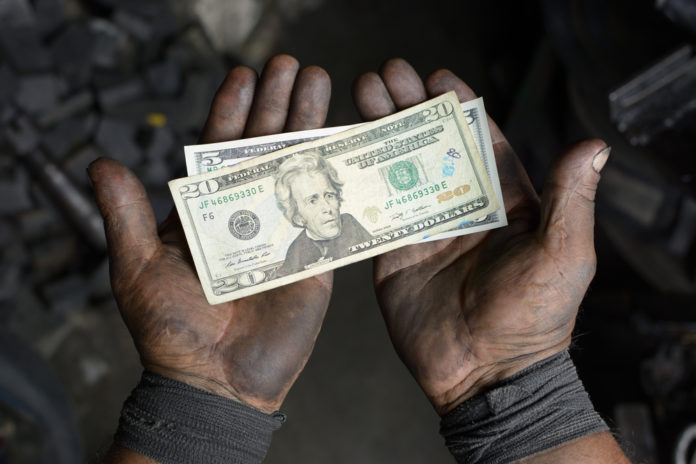“I budget and budget, and I still can’t really buy no food,” explained Carolyn Allen, a 58-year-old minimum wage worker at Hartsfield-Jackson Atlanta International Airport. She dreams of paying her medical bill and still being able to afford Pine-Sol or bleach to clean her house. Other minimum wage workers, like Laugudria Screven Jr., resort to earning income other ways — in Screven’s case, by selling his blood plasma twice a week. The strategy leaves him feeling drowsy and weak, but allows him to afford rent and approximately one meal a day.
The United States has a long, contentious history surrounding the minimum wage. Opponents of raising the minimum wage argue that most minimum wage workers are teens working their first jobs, that raising the minimum wage will kill businesses or jobs or that raising the minimum wage will have no effect at all on purchasing power because of the resulting increase in inflation. However, the arguments against raising the minimum wage range from disingenuous to objectively false. It’s time to raise the minimum wage.
The “Minimum Wage” is More Minimal Today than Ever
The United States minimum wage originated with the Fair Labor Standards Act of 1938 (FLSA), which also set overtime pay and child labor restrictions. The contemporary opposition to the FLSA foreshadowed the current arguments against raising the minimum wage. The FLSA’s opponents claimed that the president was creating a “tyrannical industrial dictatorship” and that businesses would not be able to provide any jobs if they had to cope with “everlastingly multiplying governmental mandates” and “multiplying and hampering Federal bureaucracy.”
These doomsday predictions proved untrue: the minimum wage did indeed impact the nature and distribution of employment, but industries did not buckle. At the time, two of the most low-paying industries in the South were the textile industry and the lumber industry. Southern textile mills did see a slight decrease in employment, but northern textile mills — which had paid slightly more than the southern textile mills prior to the institution of the FLSA — saw an employment increase of approximately equal magnitude. The lumber industry in the South and throughout the U.S. saw an increase in employment after the passage of the FLSA. Notably, other independent variables shifted in both industries: the textile industry had been trending to more automation prior to the bill, while the lumber industry was trending to a more labor-heavy resource base. Overall, the minimum wage leveled no industries and granted many workers a higher wage.
Over time, the minimum wage has slowly crept higher with increased inflation and productivity. However, this growth has not kept pace with other market factors, eroding the real value of the minimum wage.
Today, the real value of the minimum wage is 31 percent less than the real (adjusted for inflation) minimum wage in 1968, and 17 percent less than the real minimum wage in 2009. If minimum wage growth had tracked the growth in workers’ productivity since 1968, the minimum wage would be $18.42, more than double the federally mandated minimum wage. For comparison, productivity since 1973 has increased 74.4 percent, while average hourly compensation has increased just 9.2 percent. As of 2020, the federally mandated minimum wage of $7.25 for non-exempt workers is not enough to lift a family of two above the poverty line.
The slow growth of wages in comparison to productivity is not universal: the top 1% of workers saw their wages grow 138% since 1979, while the bottom 90% saw their wages grow 15% in the same time period. In 1965, the typical CEO earned 20 times what the typical worker did, while in 2013, the typical CEO earned 296 times the typical worker’s salary.
Increasing the Minimum Wage Would Promote Health and Well-Being
Raising the minimum wage pays social dividends that stretch beyond any debate about the discrepancies between workers’ wages and CEO’s wages.
First, workers who are affected by a minimum wage increase see immediate and significant health benefits for themselves and for society. A study conducted in 2011 found that blue-collar workers in states with higher minimum wage rates are much less likely to have untreated medical needs, as they are better able to afford care. Particularly in a country prone to global pandemics, an individual’s health can quickly become a community’s health: workers who leave illnesses untreated put everyone around them at risk. Additionally, an increased minimum wage corresponds to a lower smoking rate. Low-income workers currently make up 75 percent of smokers, but reducing the stress of poverty allows them to quit. Other studies have found that a higher minimum wage correlates with fewer teen pregnancies and less teenage alcohol consumption.
Second, children disproportionately benefit from increasing the minimum wage. Across the United States, 28.2% of children have a parent affected by increasing the federal minimum wage to $9.80, and even more have a parent who would be affected by a higher minimum wage hike. In 2017, a study conducted by the School of Public Policy at Georgia Institute of Technology found that a minimum wage increase of just $1 would reduce reports of child neglect by 9.6%. “Money matters,” said Lindsey Rose Bullinger, co-author of the study, “when caregivers have a more disposable income, they’re better able to provide a child’s basic needs such as clothing, food, medical care, and a safe home. Policies that increase the income of the working poor can improve children’s welfare, especially younger children, quite substantially.” Bullinger’s study did not have enough data to determine if an even higher minimum wage would result in even fewer cases of child neglect, but Bullinger noted, “our findings point in that direction.” Infants also benefit from increasing the minimum wage: the American Journal of Public Health estimated that between 2,800 and 5,500 premature deaths in New York City alone could have been prevented if the minimum wage was $15 an hour rather than $7 an hour. That figure constitutes approximately 8.33% of all of the premature deaths in New York City.
Opponents of raising the minimum wage frequently argue that minimum wage jobs are intended for teenagers working entry-level jobs, and that a minimum wage raise would needlessly benefit teens living at home and working for pocket money. However, this argument defies reality.
In California, 96 percent of workers who would benefit from the proposed minimum wage increase to $15 are over the age of 20, and 58 percent are over the age of 30. These numbers hold nationwide: the average age of an impacted worker would be 35, and 51 percent of those affected would be 30 years of age or older. Only 13 percent of those impacted would be 20 or younger. On average, these affected workers earn half of their family’s income, and the majority of them work full time.
Historically marginalized communities are the most likely to benefit from a minimum wage hike: in California, workers earning less than $15 per hour are 55 percent Latino or Latina, while the general population of workers is only 38 percent Latino or Latina. Nationally, about 40 percent of all black workers’ wages would increase, and more than half of workers who would be affected by a minimum wage increase are women. While 19 percent of families nationwide have incomes that are less than twice the national poverty line, 50 percent of workers who would benefit from a minimum wage increase come from these families.
Increasing the Minimum Wage Won’t Decrease Employment
Carry on a conversation about minimum wage for more than twenty minutes, and inevitably, an opponent of raising the minimum wage will inform you, often with a condescending tone, that any Econ 101 student knows that raising the minimum wage will cost jobs. Many introductory economics courses do, in fact, teach a simple theory that raising the minimum wage will reduce employment. According to this theory, as the minimum wage rises, employers will be willing to employ fewer workers, since their salaries will be more expensive.
The argument is far too simplistic to drive real-world policy for the world’s largest economy. The argument incorrectly assumes a fantasy textbook-“perfect” market. A “perfect” market has many buyers and sellers, no market power, no differences between the goods sold by each firm, and perfectly even information for buyers and sellers. (In a labor market, the “buyers” are employers, and the “sellers” are employees who are selling their time and effort.) Unsurprisingly, the US labor market is not a “perfect” market, so the opponents of increasing the minimum wage unwittingly make two huge, unjustified assumptions: first, that the demand for labor is not fixed, and second, that the wage employers pay without government intervention is the equilibrium wage.
The first assumption — that demand for labor is not fixed — describes a phenomenon known as elasticity. When a demand curve is very elastic, the buyers respond to a slight increase in the price of the good —in this case, the wage —by dramatically reducing how much of the good they consume. However, if a demand curve is very inelastic, the buyers will buy the same amount of the good with little regard to how much it costs. The demand for labor in the United States tends to be elastic if and only if: (1) the product being produced has a high price elasticity of demand, meaning that people will buy a lot less of it if it costs slightly more; (2) other factors of production can replace the labor; (3) the supply of other factors of production can be purchased or used at higher levels without their prices rising; (4) if the labor costs are a large percentage of the costs of production. While some industries fall under these categories, many do not and would therefore not be likely to see a large shift in the amount of labor demanded.
The second assumption — that wage employers pay the equilibrium wage — ignores the existence of “labor monopsonies.” A “monopsony” is a market with only one buyer — in terms of employers, it is a market with only one (or very few) employers. In the United States, economics experts have become increasingly worried that the US market has become filled with monopsonies. Rural U.S. localities in particular often have only one or two main, large employers. These employers are free to create a “race to the bottom” on wages — since there are far more workers than jobs, the dominant employer can start a reverse bidding war among job seekers, where desperate people compete with each other for work, and accept lower and lower wages. To keep wages low and desperation for employment high, these companies can limit the number of jobs to perpetuate the competition, ensuring high profit margins for themselves. However, a fixed reasonable minimum wage prevents companies from creating this desperate downward spiral and encourages them to employ a greater number of employees. In other words, monopsonies tend to employ fewer workers and pay them less when left to their own devices than they would if they were required to pay a minimum wage. In monopsony labor markets, a minimum wage would increase employment.
Of course, our Nation is made up of diverse regions, with widely varying local economies. Viewing the U.S. as a whole, would a minimum wage increase result in less employment, more employment or the same amount of employment? Setting aside politically-motivated soundbites and editorials, the economic consensus suggests that a modest increase in the minimum wage likely won’t reduce employment and may even increase it. Some estimates found that increased economic activity from a minimum wage increase to $9.80 hourly would generate 100,000 new jobs. Other economists found no reduction in employment. In 2010, Dube, Lester, and Reich studied the time period between 1990 and 2006 and found no evidence of any job losses due to minimum wage increases in industries identified as “high impact” (predominantly restaurants and retail jobs). In 2013, the same economists conducted a similar study focused on teens, and found no impact on their employment, either. A 2014 study by Hoffman agreed that teen employment was also not impacted. In 2014, Dube and Zipperer conducted a study using a newly created control group approach, and came to the same conclusion. In 2009, Addison, Blackburn, and Cotti conducted yet another study and concluded that if they accounted for general trends, they did not find any evidence of job loss due to the minimum wage in retail or restaurant sectors. Of course, some survey methods have found more significant job losses, so it’s worth looking at what has actually occurred in jurisdictions that did raise their minimum wage. A study conducted by professors at the University of California, Berkeley, and the Center of Wage and Employment Dynamics found that the minimum wage hikes in Chicago, Washington, Oakland, San Francisco, San Jose, and Seattle, had not caused “significant employment losses” but had caused “positive and statistically significant earnings effects.”
Increasing the Minimum Wage Will Benefit Small Businesses
Opponents to raising the minimum wage frequently invoke small businesses, arguing that raising the minimum wage will kill the local businesses and tip the market in favor of mega-corporations. However, if that’s true, someone forgot to tell the owners of small businesses — a study conducted by the American Sustainable Business Council found that 61 percent of small business owners across the US support raising the minimum wage. In some parts of the country, the number is even higher — it reaches 67 percent in the Northeast — and the lowest support, in the South, still reaches 58 percent. Republican pollster Frank Lutz found that 80 percent of business executives in companies of varying sizes support a minimum wage increase to some degree.
So, why do so many businesses support increasing the minimum wage?
They know that raising the minimum wage offers business a number of benefits. First, employees who are paid a higher wage tend to be more productive due to morale improvements, better health, less absenteeism and reduced “decision fatigue.” The Center for American Progress also found that raising the minimum wage causes reduced employee turnover. Employee turnover is expensive: replacing low-wage workers costs about 16% of the employee’s annual salary.
Second, the worker-productivity benefits center mostly around a given business and the wages it pays its customers. However, business owners also have reason to advocate for a minimum wage increase across the entire market. Consumers who suddenly earn more also spend more, driving up proceeds for businesses. This assertion makes logical sense: people living below or close to the poverty line frequently forgo products they wish they could afford, but with more income, they will likely purchase those products. In practice, past minimum wage increases have indeed resulted in a boost in consumer spending. A minimum wage increase to $5.85 per hour in 2007 generated an additional 1.7 billion dollars in consumer spending and a minimum wage increase in 2008 to $6.55 per hour generated an additional 3.1 billion dollars in consumer spending.
Gina Schaefer, owner of a collection of small hardware stores, notes, “When the minimum wage rises, it puts money in the pockets of those who most need to spend it, from paying the rent to buying more groceries to picking up lightbulbs, tools, and paint from the local hardware store. A higher minimum wage means more money circulating in the economy. It’s a virtuous cycle: our employees shop at other businesses and their employees shop at ours.”
Why then don’t small businesses simply increase wages on their own, without waiting for the Federal Government to intervene? Many do, and they benefit from it. But if a Federally-mandated increase is absent, others fear they will be undercut by competition.
Minimum Wage Does Not Mean Minimum Prices
Finally, opponents of increasing the minimum wage point to their own wallets: I don’t want to pay more for goods and services, so please don’t pay employees more.
But while economists concur that raising the minimum wage will likely cause prices of some goods and services to rise —so long as the raise is moderate, it will impact prices only slightly. And certainly raising the minimum wage will not cause prices to rise so much that the minimum wage hike was “useless,” as some detractors contend.
For example, studies conducted by economists at California State University, San Bernardino, found that prices of impacted goods and services increase only 0.36 percent for every 10 percent increase in the minimum wage. Therefore, raising the minimum wage does indeed allow low-income workers to afford a wider range of purchases, even if the prices have increased very slightly. For example, if a worker for $7.25 an hour receives a 10% pay raise to $7.98 an hour, they can expect a good that cost $7.30 before the minimum wage increase to cost just $7.32 after the minimum wage hike. Even with that slight price increase, the worker is vastly better off.
The United States has a long history of treating the free market as holy and rebelling against any form of government intervention. However, when big businesses and their pocket politicians advocate for keeping the minimum wage below a living wage, they aren’t just swindling their workers and damaging the economy: they’re swindling you, even if you aren’t working for minimum wage. They’re creating a less healthy, less productive, less solvent population and they’re relying on social welfare programs to pay their workers for them. Small businesses don’t benefit; workers don’t benefit. It’s time to stop pretending they do, and time to get serious about raising the federal minimum wage.
Featured Image source: WorkingNation






Comments are closed.